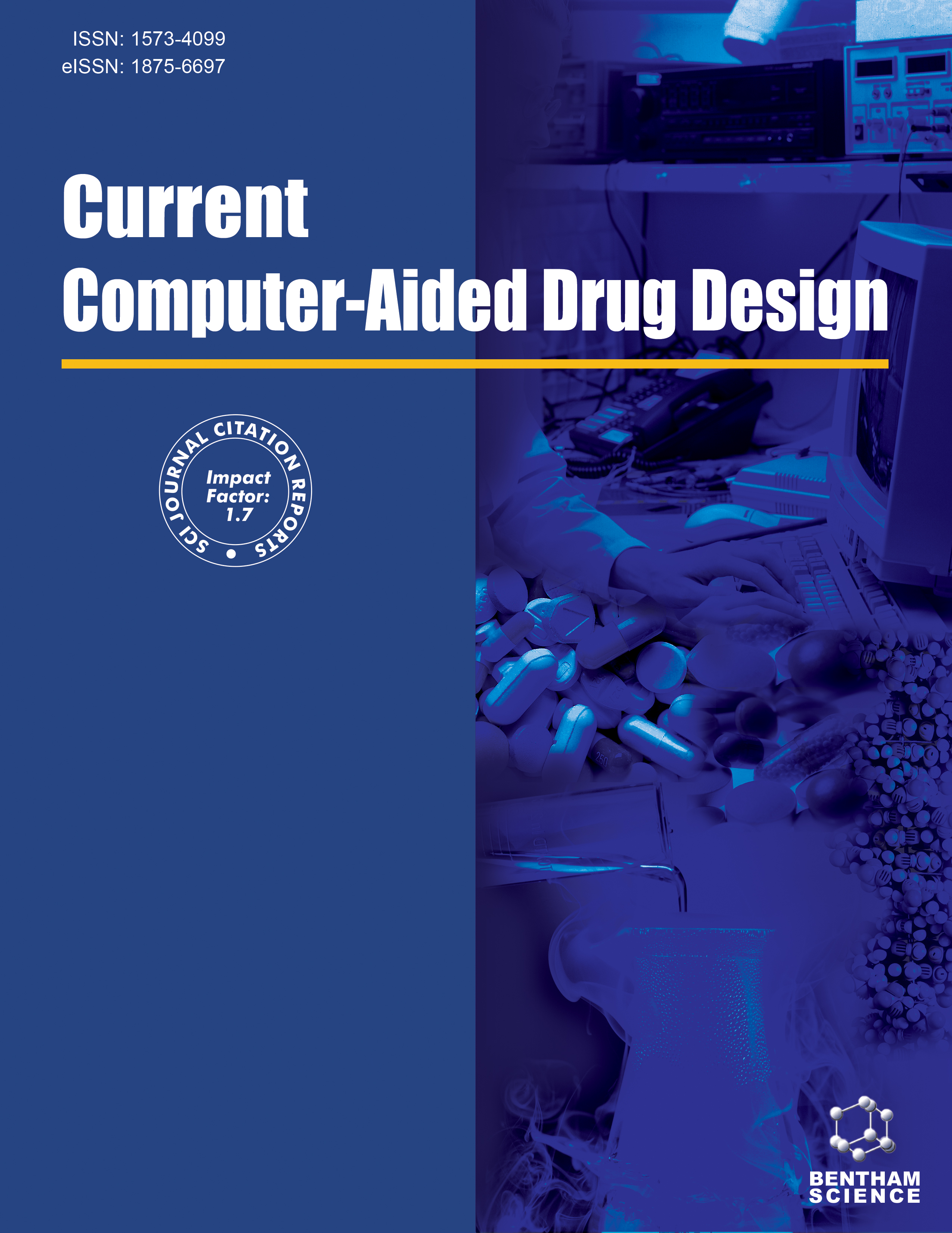- Home
- A-Z Publications
- Current Computer - Aided Drug Design
- Previous Issues
- Volume 8, Issue 4, 2012
Current Computer - Aided Drug Design - Volume 8, Issue 4, 2012
Volume 8, Issue 4, 2012
-
-
Computational Modeling Methods for QSAR Studies on HIV-1 Integrase Inhibitors (2005-2010)
More LessAuthors: Gene M. Ko, A. Srinivas Reddy, Rajni Garg, Sunil Kumar and Ahmad R. HadaeghThe human immunodeficiency virus type 1 (HIV-1) integrase is an emerging target for novel antiviral drugs. Quantitative structure-activity relationship (QSAR) models for HIV-1 integrase inhibitors have been developed to understand the protein-ligand interactions to aid in the design of more effective analogs. This review paper presents a comprehensive overview of the computational modeling methods and results of Q Read More
-
-
-
CoMFA and CoMSIA Studies on Aryl Carboxylic Acid Amide Derivatives as Dihydroorotate Dehydrogenase (DHODH) Inhibitors
More LessAuthors: Vivek K. Vyas and Manjunath GhateDHODH is a flavoenzyme that catalyzes the oxidation of dihydroorotate (DHO) to orotate (ORO) as part of the fourth and rate limiting step of the de novo pyrimidine biosynthetic pathway. Inhibitors of DHODHs have proven efficacy for the treatment of cancer, malaria and immunological disorders. 3D QSAR studies on some aryl carboxylic acid amide derivatives as hDHODH inhibitors were performed by comparative mole Read More
-
-
-
Modeling and Simulation Studies of Human β3 Adrenergic Receptor and its Interactions with Agonists
More LessAuthors: Shakti Sahi, Parul Tewatia and Balwant K. Malikβ3 adrenergic receptor (β3AR) is known to mediate various pharmacological and physiological effects such as thermogenesis in brown adipocytes, lipolysis in white adipocytes, glucose homeostasis and intestinal smooth muscle relaxation. Several efforts have been made in this field to understand their function and regulation in different human tissues and they have emerged as potential attractive targets in drug discov Read More
-
-
-
Multi-Target QSAR and Docking Study of Steroids Binding to Corticosteroid-Binding Globulin and Sex Hormone-Binding Globulin
More LessAuthors: Katarina Nikolic, Slavica Filipic and Danica AgbabaThe QSAR and docking studies were performed on fifty seven steroids with binding affinities for corticosteroid-binding globulin (CBG) and eighty four steroids with binding affinities for sex hormone-binding globulin (SHBG). Since the steroidal compounds have binding affinity for both CBG and SHBG, multi-target QSAR approach was employed to establish a unique QSAR method for simultaneous evaluation of the CBG and SHBG Read More
-
-
-
Structure- and Ligand-Based Structure-Activity Relationships for a Series of Inhibitors of Aldolase
More LessAuthors: Leonardo G. Ferreira and Adriano D. AndricopuloAldolase has emerged as a promising molecular target for the treatment of human African trypanosomiasis. Over the last years, due to the increasing number of patients infected with Trypanosoma brucei, there is an urgent need for new drugs to treat this neglected disease. In the present study, two-dimensional fragment-based quantitative-structure activity relationship (QSAR) models were generated for a series o Read More
-
-
-
Towards the Chemoinformatic-Based Identification of DNA Methyltransferase Inhibitors: 2D- and 3D-Similarity Profile of Screening Libraries
More LessAuthors: Jakyung Yoo and Jose Luis Medina-FrancoDNA methyltransferases (DNMTs) are emerging targets for the treatment of cancer and other diseases. The quinolone-based compound, SGI-1027, is a promising inhibitor of DNMT1 with a distinct mode of action and it is an attractive starting point for further research. Several experimental and computational approaches can be used to further develop novel DNMT1 inhibitors based on SGI-1027. In this work, we used a chemoinf Read More
-
-
-
Integrated Ligand Based Pharmacophore Model Derived from Diverse FAAH Covalent Ligand Classes
More LessAuthors: Lingling Shen, Hongwei Huang, Alexandros Makriyannis and Luke S. Fisher3D pharmacophore modeling is an important computational methodology for ligand-enzyme binding interactions in drug discovery. More specifically, a consensus pharmacophore model derived from diverse ligands is a key determinant upon which the prediction power of computational models is based for designing novel ligands. In this work, by merging the important pharmacophore features based on fo Read More
-
Volumes & issues
-
Volume 21 (2025)
-
Volume 20 (2024)
-
Volume 19 (2023)
-
Volume 18 (2022)
-
Volume 17 (2021)
-
Volume 16 (2020)
-
Volume 15 (2019)
-
Volume 14 (2018)
-
Volume 13 (2017)
-
Volume 12 (2016)
-
Volume 11 (2015)
-
Volume 10 (2014)
-
Volume 9 (2013)
-
Volume 8 (2012)
-
Volume 7 (2011)
-
Volume 6 (2010)
-
Volume 5 (2009)
-
Volume 4 (2008)
-
Volume 3 (2007)
-
Volume 2 (2006)
-
Volume 1 (2005)
Most Read This Month
Article
content/journals/cad
Journal
10
5
false
en


